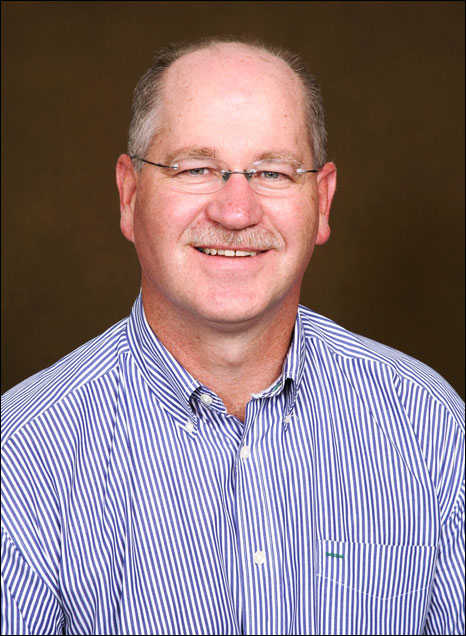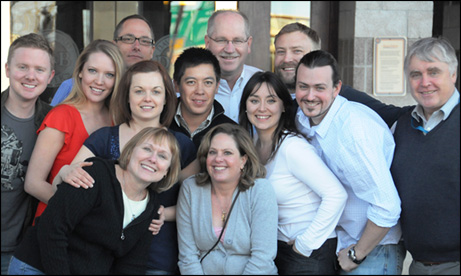 Five questions for Sean Colgan
Five questions for Sean Colgan
Director, Mucosal Inflammation Program, CU School of Medicine
Inflammatory bowel disease, or IBD, affects about 1.5 million Americans and is on the rise, especially in young children and adolescents. Other autoimmune diseases – asthma and diabetes, for instance – also are increasing in the Western world and scientists believe that an environmental trigger likely contributes to the prevalence of the disease.
One theory (The Hygiene Hypothesis) suggests that our super-clean environment doesn't allow our bodies to be exposed to the variety of bacteria that they once were, so exposure to new or different forms of microbes results in overstimulation of the immune system and attacks on the body's own cells, or autoimmunity. Genetics also play a role.
Whatever the complex reasons, Sean Colgan, Ph.D., and his team at the University of Colorado School of Medicine's Mucosal Inflammation Program hope to make new discoveries to help patients who live with these often debilitating and chronic diseases. The program focuses on the mucosa – the moist tissue that lines some organs, including the nose, mouth, lungs and digestive tract – and what happens when it becomes inflamed.
The advantage of working in autoimmune disease research – and IBD in particular, which is the umbrella for Crohn's disease and ulcerative colitis – is that there are still many unknowns, Colgan says. "These patients will be chronically managed for most of their lives, so it becomes a challenge to identify chronic management tools and take our discoveries from bench to bedside."
1. How did the program begin and what does it hope to achieve?
I came to the University of Colorado from Harvard Medical School in 2006 to initiate a research program that was focused on the basic aspects of mucosal inflammation. By any stretch of the imagination, it's been a wonderfully successful program. We have five labs from four departments that are complementary and work in close collaboration.
 |
| The team from Sean Colgan's laboratory at the Mucosal Inflammation Program: from left, front: Carol Ross and Karen Jonscher; middle, Chris MacManus, Brittelle Bowers, Aga Kendrick, Simon Keely, Louise Glover and Alan Baird; back, Doug Kominsky, Colgan and Mark Gerich. |
Part of the advantage of the program is that each of us is working on different mucosal surfaces. The labs study the esophagus, the lung, IBD and transplant immunology. We learn from each other the common pathways, the unique qualities of each surface, and we use those similarities and differences to discover new targets and define new diagnostic markers that we hope will one day improve the treatment of patients with these diseases.
2. What is your most exciting research to date?
The most exciting aspect of our work is defining what metabolic changes occur in inflamed tissue. We approach this by profiling the metabolites of inflamed lesions and tracking back to understanding which proteins are responsible for the changes in these metabolites. We can take advantage of these changes in metabolism to actually initiate healing in the tissue. Current efforts are to define pathways that normally lead us to heal, essentially using nature's way of healing to develop new drug targets.
3. How did you end up at the University of Colorado?
My love for research started as an undergraduate at Colorado State University. My original goal was to go to vet school. I started working in a research lab in the summertime at CSU and I fell in love with the lab environment. So I decided instead of going to vet school, I would pursue a Ph.D. at CSU.
I took that training to Boston where I was a post-doctoral fellow for four years at Harvard Medical School. After four years, I was fortunate to be offered a faculty position there. I stayed on faculty for another 12 years in Boston. This opportunity arose here, with the building of the new Anschutz Medical Campus. It was an opportunity for me to come back home where I grew up (in Fort Morgan), and was something I just could not pass up.
In my opinion, this is the most unique medical campus in the U.S. right now. It provides unique opportunities and if we continue to invest in the university and in the campus here, undoubtedly we will see many dreams come to fruition. I believe that in the next 10 years, this will be the place to be in this country.
4. What's a day in the life of Sean Colgan like?
My days are quite variable. I teach every day to graduate students and post-doctoral fellows and junior faculty in the lab. A normal day would consist of data analysis and designing of experiments, reviewing grants, writing manuscripts, serving on graduate committees and grant review boards.
Our other major effort is training medical fellows in the art of research. Many of them come to the lab with limited research experience, so often they require specialized attention.
I do minimal amounts of benchwork, and certainly not as much as I would like to. I miss it on a daily basis. I'm still in the lab every day and know what everyone in the lab is doing; it's just that I'm not the one pushing the pipette. But I'd like to be.
The most enjoyable aspect is watching the young scientists develop, watching their careers blossom as they go from young graduates or from post-docs to investigators with their own research programs. Another very enjoyable aspect of the job is that I get to travel and see the world, meet lots of interesting people, and see other cultures while serving on review boards or attending scientific meetings or collaborating with other researchers.
5. What does a day away from the lab consist of?
I enjoy being a good father and husband. I have two teenage boys, so it's sports and outdoor activities with them that consume much of my leisure time. We also do a lot of gardening at home where we have an acreage. My parents were farmers and taught me the tools of the trade. We have a whole menagerie of animals at the house, from dogs to birds to fish to every animal imaginable. My oldest boy has taken to raising peacocks, so by nature, I raise peacocks.
Want to suggest a faculty or staff member for Five Questions? Please e-mail Jay.Dedrick@cu.edu

|